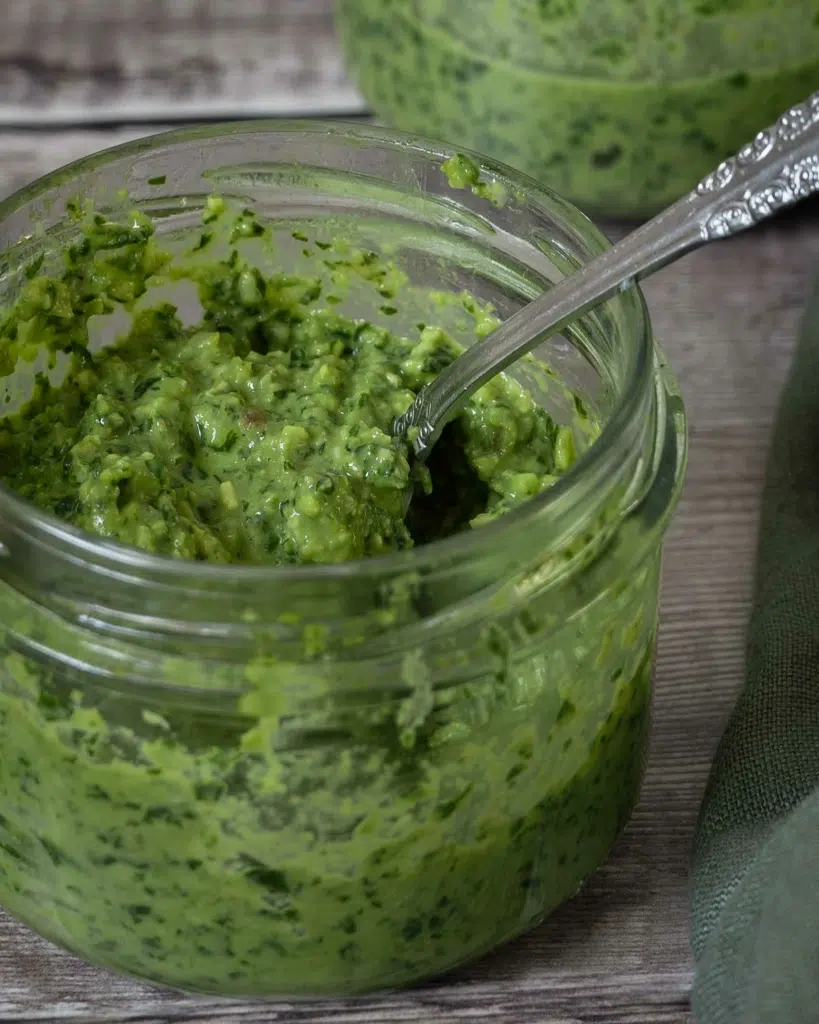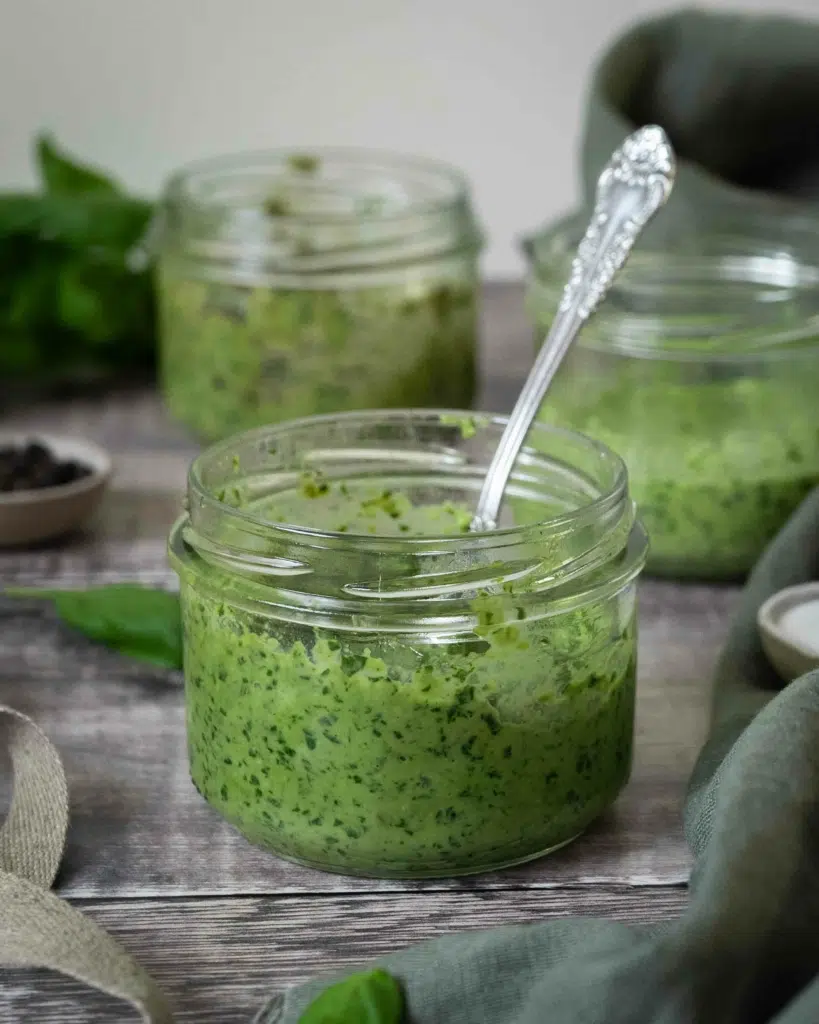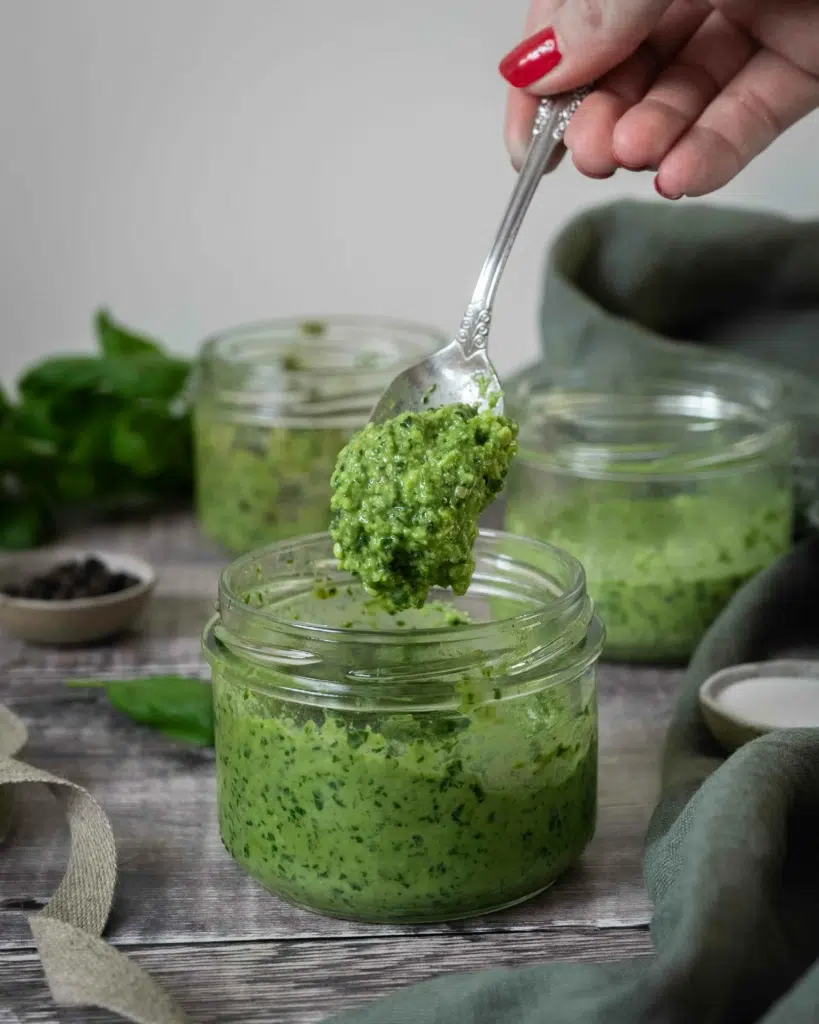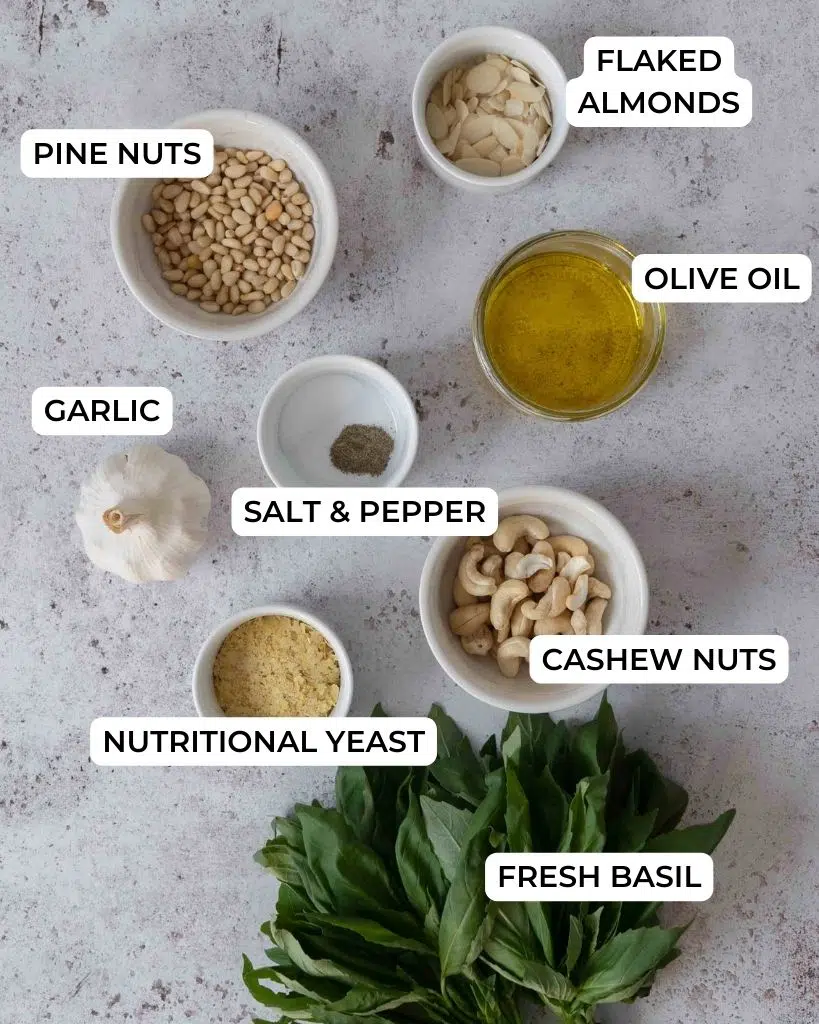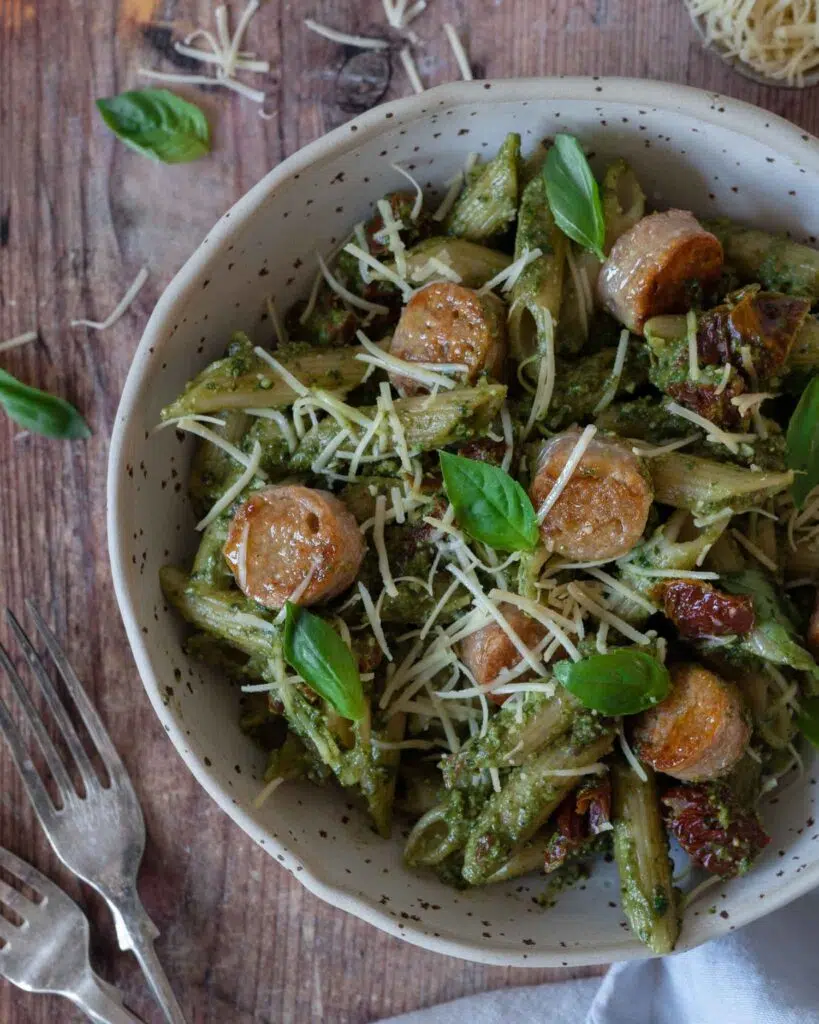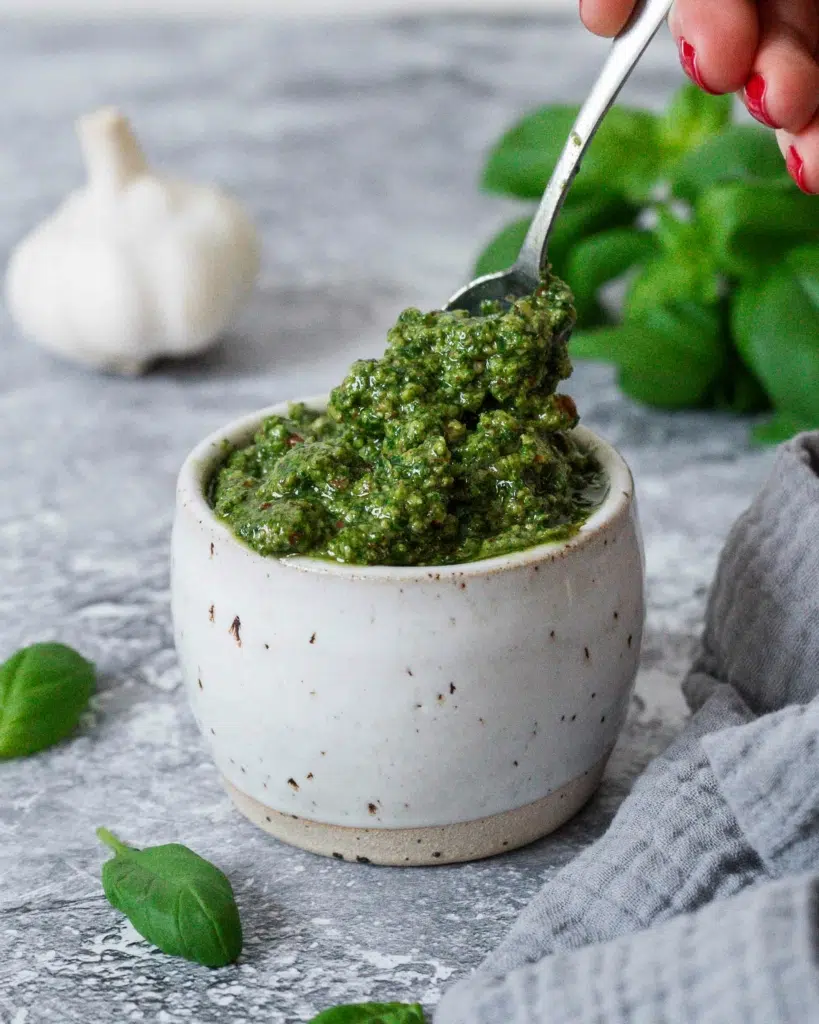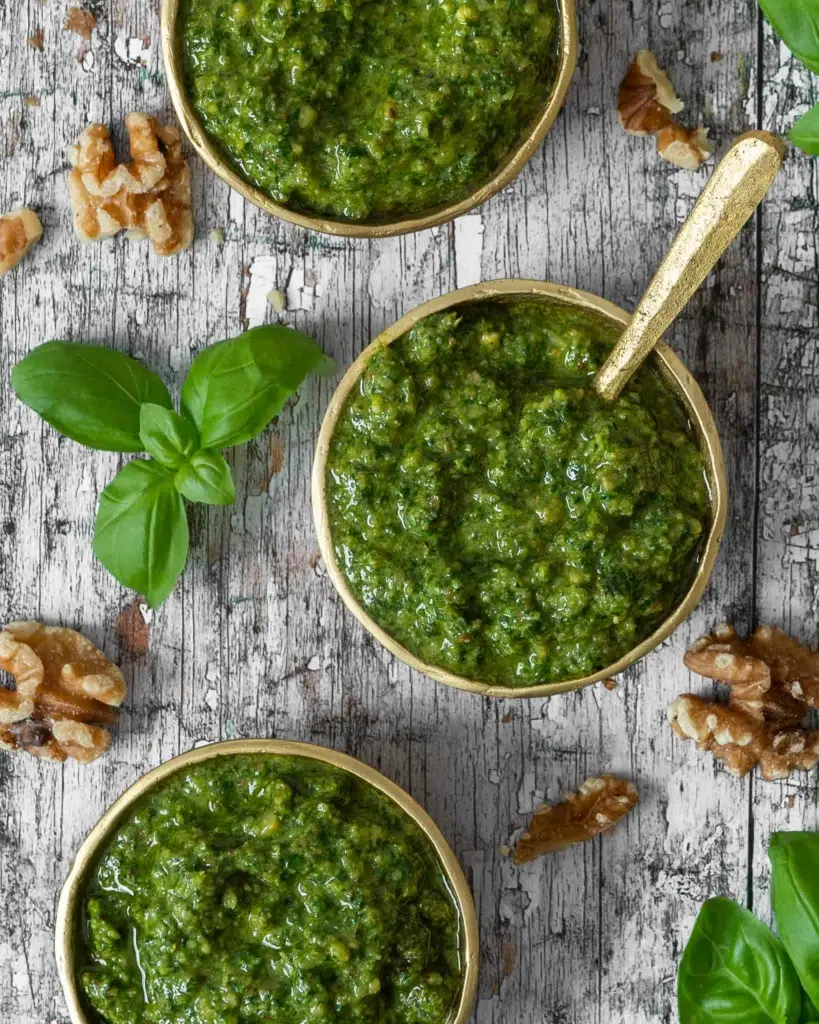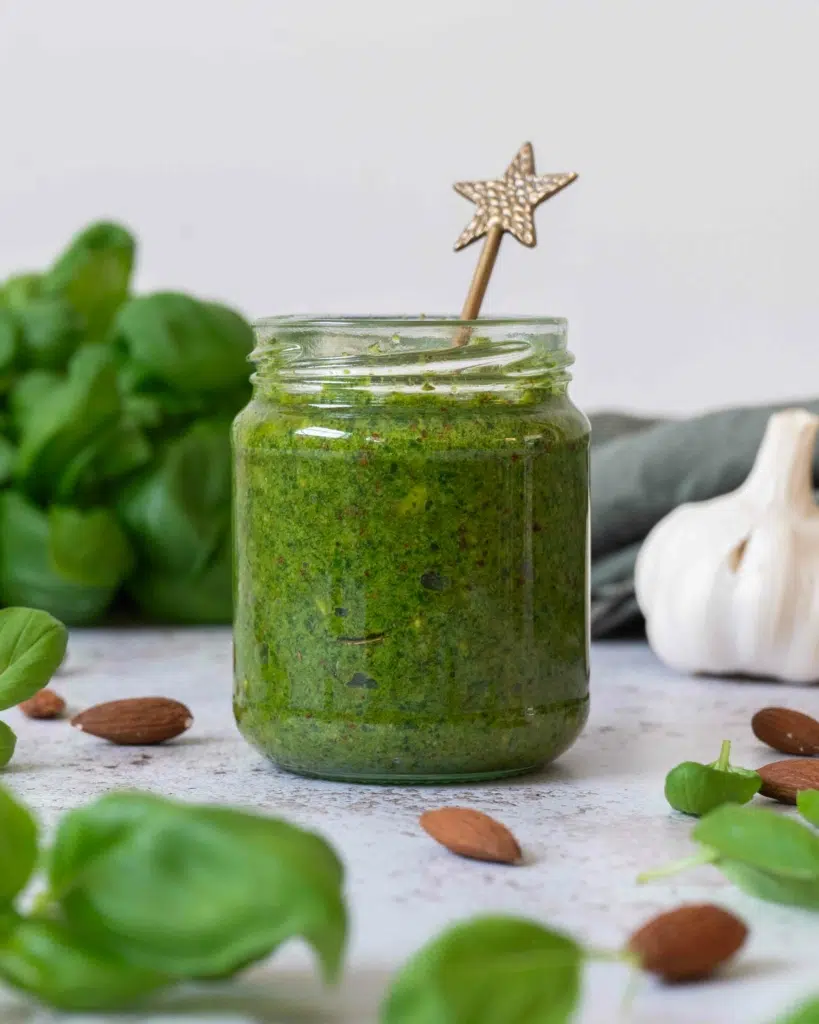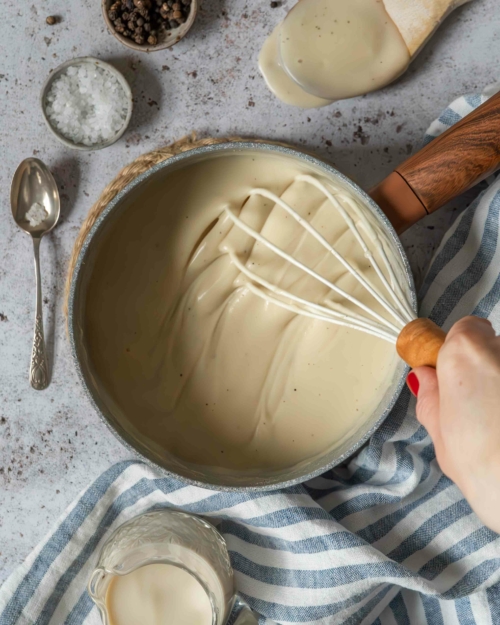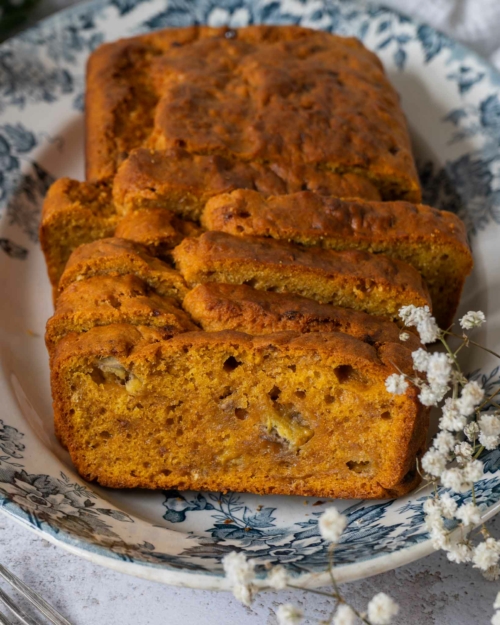No cheese is required for this dairy-free basil pesto! It takes just 5 minutes to make and is as vibrant, nutty and flavoursome as a traditional pesto. Read on to discover how to make easy homemade vegan pesto without cheese.
Traditional basil pesto contains dairy, making it unsuitable for vegans. We’re showing you how to make an easy dairy-free version in just 5 minutes with fresh, wholesome ingredients.
This vegan basil pesto is packed with flavour; balancing herbs, garlic and saltiness. Use it to elevate savoury dishes by stirring it into pasta, swirling it into soup and drizzling it over pizza and ciabattas.
Quick Links:
- The written recipe
- The video recipe
- Success tips
- Step by step instructions
- What can you eat with pesto?
- FAQs
- Other flavoursome pesto recipes like this one
Did you know? In addition to this classic Dairy-Free Basil Pesto recipe, we’ve got several other vegan pesto recipes, including:
- Nut Free Pesto
- Pesto Without Pine Nuts (we use sunflower seeds instead!)
- Almond Pesto
- Walnut Pesto
Click the recipe name above to head straight to the recipe, if you’re looking for these alternatives.
What is Pesto?
Pesto is a beloved sauce in Italian cuisine, renowned for its vibrant green colour and herby, fresh flavor. The word ‘pesto’ is derived from the Italian verb ‘pestare’, which means ‘to pound’ or ‘to crush’.
Traditionally pesto is made with fresh basil leaves, garlic, pine nuts, parmesan cheese (or pecorino cheese) and extra-virgin olive oil, combined to create a harmonious blend of flavours.
The birthplace of pesto can be traced back to the coastal region of Liguria in Northern Italy, particularly the port city of Genoa. Over time, many variations of pesto have emerged to accommodate different tastes and dietary preferences, including vegan and nut-free options.
Success Tips
Store-bought pesto can be lacklustre in flavour and colour – opt to make your own using our top tips for a flavoursome and vibrant vegan pesto:
- Use quality ingredients. Opt for fresh, high-quality basil leaves and, although any olive oil will do, use extra virgin olive oil to achieve the most delicious flavor in your vegan basil pesto. You can’t beat fresh pesto!
- Toast the pine nuts. Toasting the pine nuts before blending intensifies their nutty flavor. Follow the instructions provided in the recipe card to achieve that perfect, lightly golden hue.
- Adjust the consistency to suit. To make a thick, spreadable pesto that works well on ciabatta or in pasta, make it as per the recipe. To thin the pesto into a vegan pesto sauce that you can drizzle over pizza or salad, add a little more water until it reaches the perfect sauce consistency.
- Creative additions. Experiment with different ingredients to personalise your pesto. Try adding a roasted red pepper for a smoky flavour or a handful of sun-dried tomatoes to give a particularly delicious tangy kick.
- How to refrigerate homemade pesto. Keep your dairy free pesto in the fridge in an airtight container for up to 3 days. Add a thin layer of olive oil on top of the pesto, or cover with a layer of eco-cling film before adding your container lid to help preserve the colour.
- How to freeze homemade pesto. Homemade pesto freezes well. Pop it into an ice cube tray for ready to use single-serve portions. Once frozen the pesto cubes can be transferred to an airtight container or sealed bag and stored in the freezer for up to 2 months. If you’ve got your own basil plants, make a batch of fresh pesto in the summer to use over the coming months.
How to make this Dairy-Free Basil Pesto
Ingredients
Pine nuts – toasted is a must for flavour
Cashew nuts
Flaked almonds
Fresh basil leaves
Nutritional yeast – the secret ingredient used to add a cheesy flavor
Olive oil – ideally extra virgin
Garlic – opt for fresh garlic if possible
Seasoning – sea salt and black pepper
Water – used to thin the pesto
Equipment
You’ll need a food processor for this recipe, along with a small frying pan for toasting the pine nuts if they are not already pre-toasted.
Steps
Make sure to head to the recipe card below for the full recipe and instructions! Here’s how to make this easy vegan pesto recipe:
Gather together your ingredients.
Add the toasted pine nuts and basil to a food processor along with all of the other ingredients and pulse until combined. Scrape down the sides of the processor bowl and pulse again as necessary.
Tip: If your pine nuts are not already toasted, add them to a dry frying pan (no oil) and toast them over a low heat until they are lightly golden. This will take around 10 minutes.
Store the pesto in the fridge in an airtight container for up to 3 days. To preserve the colour as best as possible, cover the pesto with eco cling film (with the film touching the top of the pesto) or add a thin layer of olive oil before adding an airtight lid.
Alternatively, freeze the pesto into ice cube trays for ready-to-use single servings that will last for 2 months in the freezer. It’s great to use in pasta, like this Crispy Sausage and Sun-Dried Tomato Pesto Pasta!
What can you eat with pesto?
Pesto can be enjoyed with a wide variety of dishes. Here are some different ways you can enjoy this vegan version of a traditional pesto:
- Stirred into pasta. Create a simple light pesto pasta or a more hearty meal like this flavoursome Crispy Sausage Pasta with Sun-Dried Tomato and Pesto. You can also stir it into your favorite pasta sauce.
- In sandwiches or on toast. Fry a cut ciabatta in olive oil until lightly golden and then top with fresh rocket, fried cherry tomatoes and a drizzle of pesto. So delicious!
- As a dip. Pair it with crackers, breadsticks, crudités and vegan cheese sticks, along with our White Bean Hummus for a party or evening with friends.
- As a pizza sauce or drizzle. You could opt to use this to top your pizza base instead of the classic tomato sauce, or drizzle it on top of a cooked roasted vegetable pizza.
- Drizzle over buddha bowls or use as a salad dressing. Add flavour and colour to your summer salad with this beautifully vibrant and easy dairy-free pesto recipe.
- Stir into soup. Stir this delicious pesto into soup for a flavour burst, such as this Farmhouse Vegetable Soup.
FAQs
What can I use instead of cheese in pesto?
Traditional basil pesto contains dairy in the form of parmesan cheese, which is typically not vegan or vegetarian. To make dairy free pesto, with a similar cheesy flavour, we use nutritional yeast which is a dried yeast flake available in many supermarkets.
Alternatively, you can use shop-bought vegan parmesan instead, just make sure it’s one you love the flavour of!
If you don’t want that mild cheesy flavour, you can omit the nutritional yeast from this dairy free pesto recipe.
How long does pesto last?
Pesto will last for 3 days when stored in the fridge in an airtight container, or in the freezer for up to 2 months.
When storing in the fridge, cover the pesto with eco cling film (with the film touching the top of the pesto) or add a thin layer of olive oil before adding an airtight lid. This will help to preserve the colour.
Can I freeze pesto?
Yes, pesto can be frozen for up to 2 months. Add the pesto to an ice-cube tray and, once frozen, transfer these cubes to an airtight container or bag. Each cube will make a perfect single-serving that can either be added straight to the pan to melt and stir into pasta, or defrosted in the fridge to drizzle over soups and salads.
Loved this classic dairy-free basil pesto? Here are some more classic pesto recipes to try
I hope you LOVE this recipe for Dairy-Free Basil Pesto! Share this blog with someone you think will love it and don’t forget to tag @aveganvisit on social media when you try out the recipe. I absolutely love seeing your re-creations! Enjoy 🙂 x
If you make this recipe, please leave a comment and star rating below – this provides helpful feedback to both me and other readers. If you want more delicious vegan recipes be sure to subscribe to the A Vegan Visit newsletter. We’d also love for you to join the AVV community on Youtube, Tiktok, Instagram, Pinterest and Facebook.
The Video Recipe:
The Written Recipe:

Classic Vegan Pesto (5 Minute Dairy Free Basil Pesto)
Ingredients
- 40 g pine nuts (toasted*)
- 60 g fresh basil leaves
- 30 g cashew nuts
- 15 g flaked almonds
- 7 g nutritional yeast
- 50 ml olive oil (extra-virgin ideally)
- 3 small cloves garlic (minced (or 2 medium cloves))
- ¼ tsp salt (more to taste)
- ⅛ tsp ground black pepper
- up to 40 ml of water to loosen the mixture
Instructions
- Add all of the pesto ingredients to a food processor, starting with 1/4 tsp salt.Pulse until combined, scraping down the sides of the processor bowl as necessary before blending again. Add a little water as needed during the blending process to achieve the desired consistency for your pesto (thick for spreadable, thinner for a sauce).Taste and add more salt if desired.Note: If your pine nuts are not already toasted then add them to a dry (no oil) frying pan. Fry them over low heat, stirring occasionally, until lightly golden - this should take around 10 minutes.40 g pine nuts, 60 g fresh basil leaves, 30 g cashew nuts, 15 g flaked almonds, 7 g nutritional yeast, 50 ml olive oil, 3 small cloves garlic, 1/4 tsp salt, 1/8 tsp ground black pepper, up to 40 ml of water to loosen the mixture
- To store the pesto, add it to a dish and cover it in eco cling film (with the film touching the top of the pesto) and then add an airtight lid. Alternatively, you can add a thin layer of olive oil on top of the pesto instead of using cling film, before adding an airtight lid.
- Store the pesto in the fridge for up to 3 days, or freeze using an ice cube tray for single servings that you can use for a quick meal.

